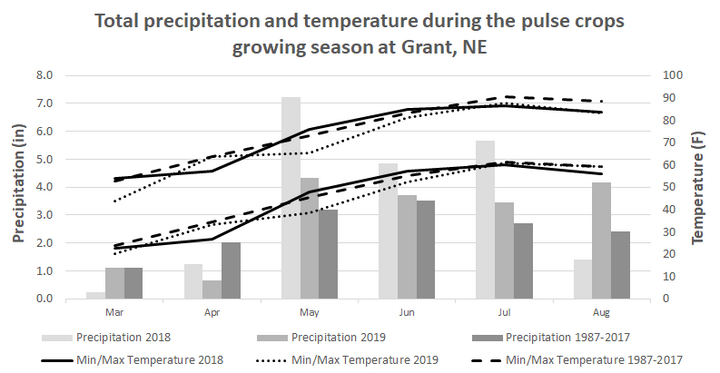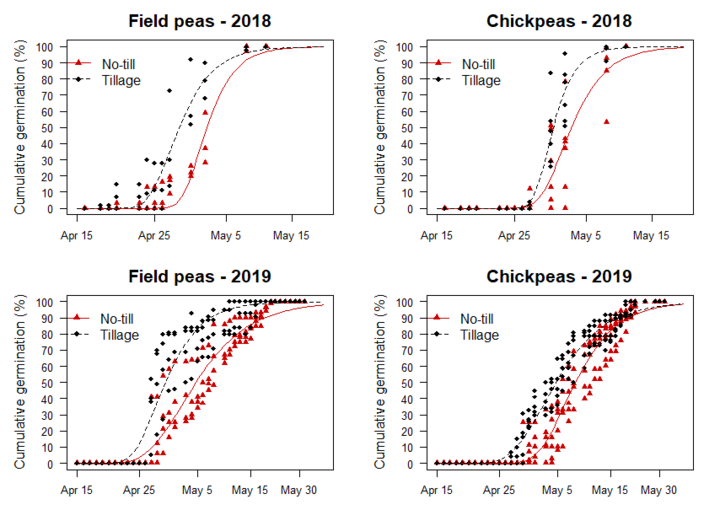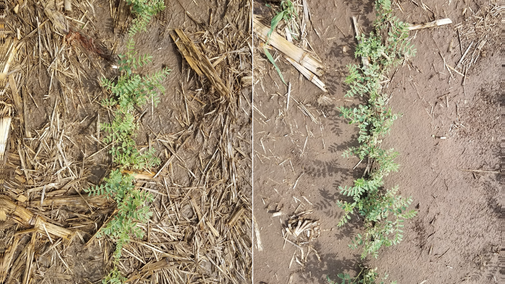Field peas and chickpeas are pulse crops often grown as a fallow replacement in western Nebraska dryland cropping systems (wheat-fallow or wheat-corn-fallow). Although the most dominant cropping system is no-till, several farmers observed that tillage prior to planting produced better field pea yields. Possible reasons for increased yields with tillage are often attributed to
- earlier and more uniform emergence and canopy development,
- better weed suppression,
- extended flowering (reproductive) periods, and
- uniform maturity and dry down at harvest.
A field study was undertaken to evaluate the effects of tillage on germination patterns and grain yield of yellow field peas and chickpeas.
Trial Summary
The study was conducted at the Henry J. Stumpf International Wheat Research Center at Grant, Nebr. during the 2018-2019 growing seasons. The predominant soil type in the study area was Kuma silt loam. In 2018 field peas and chickpeas were grown behind corn; in 2019 crops were grown behind winter wheat. Both years tillage was performed in tillage blocks using a Krause 32-foot tandem disk (heavy disk). The study area was sprayed with a PRE herbicide (Spartan Elite®) within a week before planting. At planting, chickpea seed was treated with seed fungicide (Obvious®) and both field pea and chickpea seed were inoculated with full rates of liquid and peat inoculants (Cell-Ttech®).
The field pea variety Durwood was planted on March 14 and March 29 in 2018 and 2019, respectively. Field pea seeding rate was 350,000 live seeds per acre and planting was performed using a 20-foot Crustbuster no-till box drill with a 7.5-inch row spacing. Two chickpea varieties, Frontier and Orion, were planted on March 23 and March 29 in 2018 and 2019, respectively. The seeding rate for chickpeas was 220,000 live seeds per acre in 15-inch rows and planting was performed using two passes with an eight-row John Deere® planter. Field peas were harvested on July 20 in 2018 and July 25 in 2019. Chickpeas were desiccated using generic paraquat seven days before being harvested on August 17 in 2018 and August 20 in 2019.

Germination
Slow germination of both field peas and chickpeas can be attributed to early planting (mid- to late March) in combination with cool springs in both 2018 and 2019 (Figure 2). Although it took 28-46 days to achieve 10% germination (late-April), it took 7-14 days for field peas and chickpeas to finish germinating (Figure 3, Table 1).
Tillage had a positive impact on germination. The germination started, progressed, and finished earlier in tillage treatments, regardless of the crop (Table 1; Figure 3). In 2018, field pea germination at 10%, 50%, and 90% occurred 46, 49, and 54 days after planting, respectively; this was 4, 4 and 2 days earlier than the 10%, 50%, and 90% field pea germination in no-till blocks, respectively (Table 1). Similar trends occurred in 2018 chickpeas and in the 2019 growing season.
Compared to tilled fields, no-till planted field peas finished germinating (90% germination) 2 and 9 days later in 2018 and 2019, respectively; germination in no-till chickpeas was delayed by 5 days in 2018 and by 3 days in 2019 (Table 1, Figure 3).
Grain Yield
Tillage either maintained or increased the grain yield of field peas and chickpeas. In 2018, grain yield of field peas was increased by 12 bu/ac while chickpea yield was increased by 6 bu/ac. There was no impact of tillage on grain yield in 2019 (Figure 4).
| Pulse Crop Year |
Tillage | 10% germination | 50% germination | 90% germination | ||||||
| DAP | Date | DAP | Date | DAP | Date | |||||
| Field peas 2018 |
no-till | 46 | 29-Apr-18 | 49 | 2-May-18 | 54 | 7-May-18 | |||
| tillage | 42 | 25-Apr-18 | 45 | 28-Apr-18 | 52 | 5-May-18 | ||||
| Chickpeas 2018 |
no-till | 37 | 29-Apr-18 | 41 | 3-May-18 | 47 | 9-May-18 | |||
| tillage | 36 | 28-Apr-18 | 38 | 30-Apr-18 | 42 | 4-May-18 | ||||
| Field peas 2019 |
no-till | 27 | 25-Apr-19 | 38 | 6-May-19 | 48 | 16-May-19 | |||
| tillage | 25 | 23-Apr-19 | 29 | 27-Apr-19 | 37 | 5-May-19 | ||||
| Chickpeas 2019 |
no-till | 32 | 30-Apr-19 | 38 | 6-May-19 | 49 | 17-May-19 | |||
| tillage | 28 | 26-Apr-19 | 35 | 3-May-19 | 46 | 14-May-19 | ||||
| * Planting dates: Field peas 2018 (March 14), chickpeas 2018 (March 23), field peas and chickpeas 2019 (March 29) | ||||||||||


Grain Yield
Tillage either maintained or increased the grain yield of field peas and chickpeas. In 2018, grain yield of field peas was increased by 12 bu/ac while chickpea yield was increased by 6 bu/ac. There was no impact of tillage on grain yield in 2019 (Figure 4).
Recommendation
We caution farmers to use tillage as a strategy to increase the grain yield of field peas and chickpeas, especially under dryland conditions of semiarid climates such as southwest Nebraska. Although faster germination can be seen as a benefit, tillage often causes issues with crusting, ponding, and increases soil evaporative and erosion potential. Moreover, tillage increases the production cost without a secure return on the investment.
Planting field peas and chickpeas is often challenging in a heavy crop residue. Lighter tillage (e.g., vertical till) or various field operations such as residue chopping or light residue grazing during the winter months may be more suitable strategies in creating favorable planting conditions for field peas and chickpeas.

